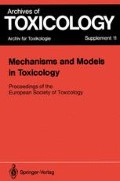Abstract
It is now well established that the toxic effects of a variety of chemicals are mediated by reactive products formed during their biotransformation in the organism. It is equally clear that there exist protective systems which can trap or inactivate toxic metabolites and thereby prevent their accumulation within the tissues and subsequent toxicity. Although phase I reactions, in particular those mediated by the cytochrome P450-linked monooxygenase system, are most often responsible for the production of toxic metabolites, there are now many examples of metabolic activation via phase II reactions, despite the fact that the latter normally serve a protective function (Jakoby 1980). It therefore follows that the formation of toxic metabolites cannot be attributed to any single enzyme or enzyme system, and that the balance between metabolic activation and inactivation is critical in deciding whether exposure to a potentially toxic compound will result in toxicity or not.
Access this chapter
Tax calculation will be finalised at checkout
Purchases are for personal use only
Preview
Unable to display preview. Download preview PDF.
References
Bellomo G, Jewell SA, Thor H., Orrenius S (1982) Regulation of intracellular calcium compartmentation; studies with isolated hepatocytes and t-butyl hydroperoxide. Proc Natl Acad Sci USA 79:6842–6846
Bellomo G, Mirabelli F. Richelmi P, Orrenius S (1983) Critical role of sulftiydryl group(s) in ATP-dependent Ca2+ sequestration by the plasma membrane fraction from rat liver. FEBS Letters 163:136–139
Bellomo G, Nicotera P, Orrenius S (1984) Alterations in intracellular Ca2+ compartmentation following inhibition of Ca2+ efflux from isolated hepatocytes. Eur J Biochem 144:19–23
Cheung WY (1980) Calmodulin plays a pivotal role in cellular regulation. Science 207:19–27
Chien KR, Abrams J, Pfau RG, Farber JL (1977) Prevention by chlorpromazine of ischemic liver cell death. Am J Pathol 88:539–558
Chien KR, Pfau RG, Farber JL (1979) Ischemic myocardial cell injury. Prevention by chlorpromazine of an accelerated phospholipid degradation and associated membrane dysfunction. Am J Pathol 97:505–530
Collier NC, Wang K (1982) Purification and properties of human platelet P235. J Biol Chem 257:6937–6943
Cooper RH, Coll KE, Williamson JR (1985) Differential effects of phorbol ester on phenylephrine and vasopressin-induced Ca2+ mobilization in isolated hepatocytes. J Biol Chem 260:3281–3288
Di Monte D, Bellomo G, Thor H, Nicotera P, Orrenius S (1984) Menadione-induced cytotoxicity is associated with protein thiol oxidation and alteration in intracellular Ca2+ homeostasis. Arch Biochem Biophys 235:343–350
Jakoby WB (1980) Enzymatic basis of detoxication, vols 1, 2. Academic, New York
Jewell SA, Bellomo G, Thor H, Orrenius S, Smith MT (1982) Bleb formation in hepatocytes during drug metabolism is caused by disturbances in thiol and calcium ion homeostasis. Science 217:1257–1259
Larsson A, Orrenius S, Holmgren A, Mannervik B (1983) Functions of glutathione: biochemical, physiological, toxicological and clinical aspects. Raven, New York
Lehninger AL, Vercesi A, Bababunmi E (1978) Regulation of Ca2+ release from mitochondria by the oxidation-reduction state of pyridine nucleotides. Proc Natl Acad Sci USA 75:1690–1694
Moore L, Chen T, Knapp HR, Landon E (1975) Energy-dependent calcium sequestration activity in rat liver microsomes. J Biol Chem 250:4562–4568
Nicotera P, Moore M, Mirabelli F, Bellomo G, Orrenius S (1985) Inhibition of hepatocyte plasma membrane Ca2+-ATPase activity by menadione metabolism and its restoration by thiols. FEBS Letters 181:149–153
Nicotera P, Hartzell P, Baldi C, Svensson S-Å, Bellomo G, Orrenius S (1986a) Cystamine induces toxicity in hepatocytes through the elevation of cytosolic Ca2+ and the stimulation of a non-lysosomal proteolytic system. J Biol Chem 261:14628–14635
Nicotera P, Hartzell P, Davies G, Orrenius S (1986b) The formation of plasma membrane blebs in hepatocytes exposed to agents that increase cytosolic Ca2+ is mediated by the activation of a non-lysosomal proteolytic system. FEBS Letters 209:139–144
Rivett JA (1985) Preferential degradation of oxidatively modified form of glutamine synthetase by intracellular mammalian proteases. J Biol Chem 260:300–305
Seglen PO, Grinde B, Solheim AE (1979) Inhibition of the lysosomal pathway of protein degradation in isolated rat hepatocytes by ammonia, methylamine, chloroquine and leupeptin. Eur J Biochem 95:215–225
Smith MT, Thor H, Jewell SA, Bellomo G, Sandy MS, Orrenius S (1984) Free radical-induced changes in the surface morphology of isolated hepatocytes. In: Armstrong D, Sohal RS, Cutler RG, Slater TF (eds) Free radicals in molecular biology, aging and disease. Raven, New York, vol 27, pp 103–118
Author information
Authors and Affiliations
Editor information
Editors and Affiliations
Rights and permissions
Copyright information
© 1987 Springer-Verlag
About this paper
Cite this paper
Orrenius, S., Nicotera, P. (1987). On The Role of Calcium in Chemical Toxicity. In: Chambers, C.M., Chambers, P.L., Davies, D.S. (eds) Mechanisms and Models in Toxicology. Archives of Toxicology, Supplement, vol 11. Springer, Berlin, Heidelberg. https://doi.org/10.1007/978-3-642-72558-6_2
Download citation
DOI: https://doi.org/10.1007/978-3-642-72558-6_2
Publisher Name: Springer, Berlin, Heidelberg
Print ISBN: 978-3-540-17614-5
Online ISBN: 978-3-642-72558-6
eBook Packages: Springer Book Archive

